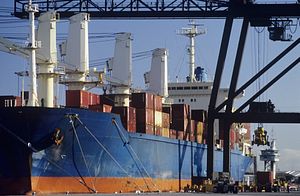Australia and Korea’s Free Trade Agreement (KAFTA) takes effect today, after a deal was reached at the end of 2013. Talks began in 2008 under the previous Kevin Rudd-led Labor government. The KAFTA is one of three recent Asian FTAs for Australia, the others being Japan and China. The Diplomat has previously reported on Australia’s FTA with China and its purported A$18 billion ($14.9 billion) worth of promise. As we said then it is largely predicated upon “the evergreen promise of ‘China’s growing middle class.’” Korea has an established middle class already, though GDP per capita is apparently half what it is in Australia.
There is great potential in the KAFTA but relatively little attention has been paid to it. Why? Dr. Malcolm Cook of Flinders University, a non-resident fellow at the Lowy Institute, told The Diplomat, “There is a powerful cumulative effect that favors the conflation of Asia and China. The Australian government, universities, media, firms, etc. have increased their investment in knowledge of China and often reduced it for other Asian states.” Cook has written on both the China FTA and Korea-Australia relations for Lowy (including here).
On first blush, Australia and South Korea share much: “middle power” status, strong security relations with the United States, and a large measure of economic dependence on China. However as Cook has pointed out, middle power cooperation is more useful as rhetoric than as practical outcomes.
The Australia-Korea Foundation was established in 1992 through Australia’s Department of Foreign Affairs and Trade (DFAT); the Korea-Australia Foundation in 1991. DFAT has reports available online for the former, but only up until the 2008-2009 period. Similarly, trade details between the two nations are only available for the 2012-2013 period. One thing that is notable is that Australia sold A$788 worth of beef to Korea. Keep in mind that only a few weeks ago the government was trumpeting its triumph in securing a possible A$1 billion deal with China, outside of the FTA (which had not at that point been signed). The figure was most likely erroneous given Australia did not have enough cattle to send that much beef to China without possibly damaging trade relations with Indonesia.
It is in agricultural exports that Australia might do well in Korea, and be able to compete with the U.S. in terms of beef sales (Korea has an FTA with the U.S. also: KORUS). Korea has traditionally been tremendously protectionist, even isolationist, and it has only been in recent years that it is has really started to break out from the chaebol system and become more internationally integrated. Interestingly, Korea’s left is generally more anti-foreign and sees both the U.S. and Japan as imperialist. Australia is seen in more positive terms and its beef already enjoys success in Korea as a competitor to U.S. product. The “Made in Australia” trademark – a gold kangaroo on a green background – was registered in Korea last year and in China in 2012. Services may also be a growth area: Macquarie Bank has had success in Korea and sponsors events there. Korean investment in Australia is already A$12 billion and may be another growth area.
Trade minister Andrew Robb told media Friday that the deal would see tariffs of up to 550 percent cut to nothing and that beef sales would rise 40 percent over the next 15 years. A full list of eliminated tariffs can be seen here.
Australia is not the only Korean trading partner to be strengthening ties. Vietnam announced this week that it has concluded its own FTA with South Korea. Vietnam is Korea’s ninth largest trading partner, and fourth largest investment destination.
Helen Clark was based in Hanoi for six years as a reporter and magazine editor. She has written for two dozen publications including The Diplomat (as Bridget O’Flaherty), Time, The Economist, the Asia Times Online and the Australian Associated Press.
































